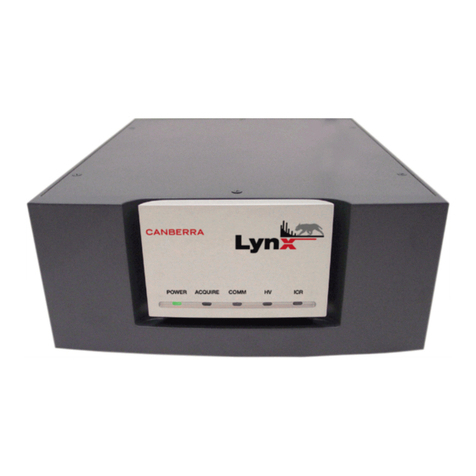
Applications
This section is not intended as a complete survey of applications. It is intended to
highlight the most important features of the module and to indicate representative ar-
eas where they might be applied.
The Model 2015A overcomes the past necessity of using two individual modules, an
amplifier and single channel analyzer, by performing both tasks in one convenient sin-
gle-width module.
The amplifier’s two selectable time constants, 0.5 µs for high count rates and 2 µs for
optimum resolution, makes it useful for NaI, Ge(Li), surface barrier and proportional
counter applications. Using the amplifier and single channel analyzer outputs, the
Model 2015A, in conjunction with a delay module, represents an ideal method for per-
forming energy discrimination. The SCA OUTPUT can gate the multichannel analyzer
to control the acceptance or rejection of the amplifier’s delayed linear output signal. In
addition, the amplifier’s output allows the signal to be analyzed by other energy
discriminators so that more than one energy band may be selectively studied from the
same amplifier.
The Single Channel Analyzer section is used in either the Timing SCA (TSCA) or
SCA mode. In the timing mode, the SCA OUTPUT logic pulse is placed consistently
in time (200 nanoseconds) past the AMPLifier OUTPUT pulse peak. Thus, the Model
2015A may serve to replace an amplifier and individual timing SCA, sometimes re-
quired for coincidence experiments. With its SCA and ULD or LLD DISC outputs, the
2015A Amp/TSCA may be used to identify two different energies or particles depend-
ing on the particular setting of the discriminator levels.
Low Level Counting System
The Canberra LOW BACKGROUND ALPHA/BETA DETECTOR SYSTEM (2200
& 2201) depicts a particular application of the Model 2015A. In this system, two de-
tectors are used in anti-coincidence to distinguish true sample events from cosmic or
interference radiation associated with the local environment. The system is ideally
suited for measuring isotopes such as 14C, 89Sr, 210Po, and so forth.
There are two Model 2015A Amp/TSCA modules involved in this system configura-
tion. One is used in the guard channel path and the other in the sample channel path. In
the guard channel the Model 2015A is used as an amplifier/discriminator combination,
where the extremely low threshold setting of the LOWER LEVEL (E) discriminator is
used to detect the cosmic events. The Model 2209A, monitoring the guard 2015A
DISC (ULD = LLD) output, gates off or inhibits the Scaler/Timer when a cosmic
INPUT signal exceeds the LOWER LEVEL (E) threshold.
2
Introduction





























